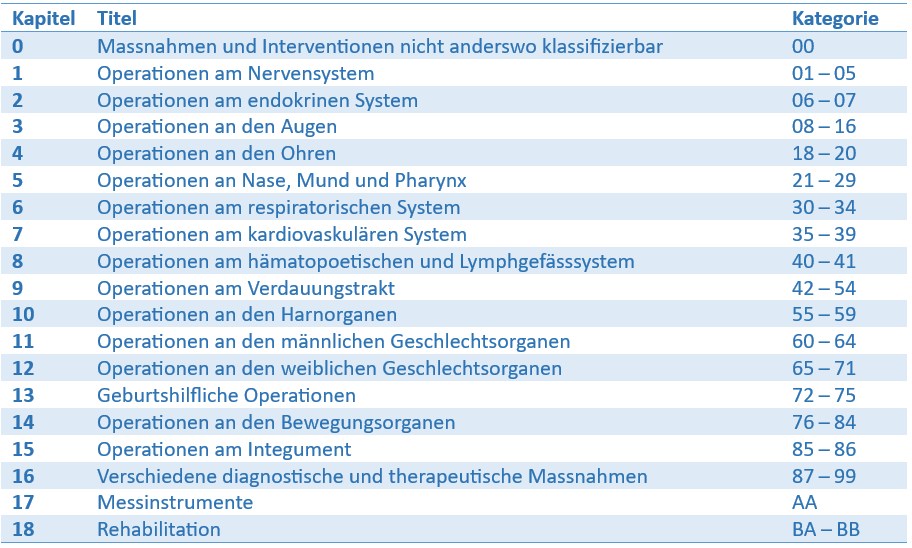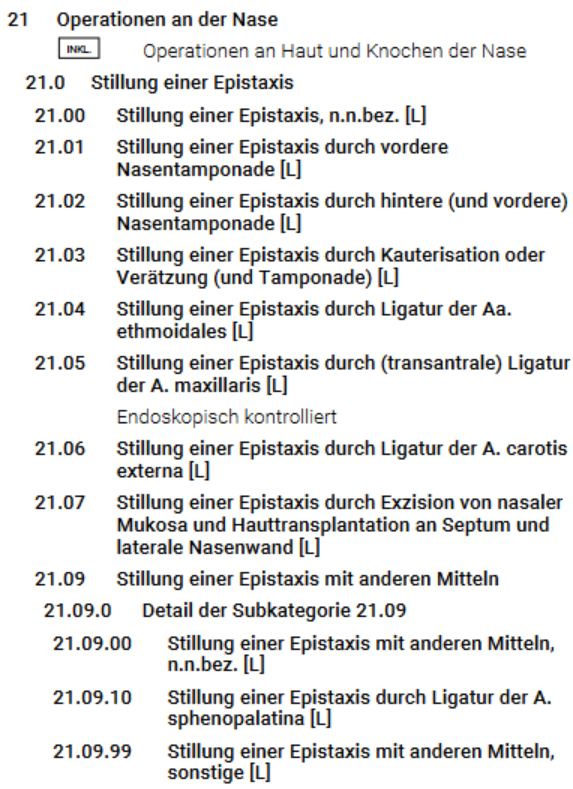CHOP Catalogue
The CHOP catalogue is the Swiss surgical classification and, like the ICD catalogue, consists of a Tabular List and an Alphabetic Index. The CHOP catalogue is updated and published annually by the Federal Statistical Office (FSO).
All Swiss hospitals with inpatient cases (hospitals, maternity clinics, rehabilitation clinics, psychiatric clinics) are obliged to code the treatments of their patients using the procedure codes from the CHOP catalogue. In addition to being used to compile various statistics in the Swiss healthcare system, the coded CHOP codes are used in particular in the three inpatient tariff systems to group cases.
Structure of the CHOP catalogue
The CHOP catalogue has a similar basic structure to the ICD catalogue with an Anlphabetic Index and Tabular List. CHOP codes have two to six digits and are alphanumeric, i.e. they consist of numbers and letters.
Tabular List
The CHOP catalogue is divided into a total of 19 chapters. The largest part of the CHOP catalogue (chapters 1-15) is oriented towards the different organ systems of the human body.

Each chapter is composed of different categories. The two-digit numbers or letters defining a category are used for the first two digits of each CHOP code. This is followed by a full stop. After that, the codes are further subdivided into categories (3-digit), subcategories (4-digit), groups of elements (5-digit) and elements (6-digit). A dot is again placed between the fourth and fifth digit of the code.
Only terminal codes may be coded, i.e. codes that have no further subdivisions. The code can have 3 to 6 digits. The excerpt below (only in German) from the CHOP catalogue 2023 shows the beginning of chapter 5 with the first codes of category 21 “Operationen an der Nase (Operations on the nose)”. In this extract, for example, both the 4-digit code 21.00 and the 6-digit code 21.09.00 are terminal.

The classification within a category by means of subcategories predominantly shows an increasing complexity. This means that less complex interventions are usually found at the beginning of each category. In principle, the following order applies, which, however, cannot always be adhered to:
1. incision, puncture
2. biopsy and other diagnostic measures
3. excision or partial destruction of a lesion or tissue
4. excision or total destruction of a lesion or tissue
5. suturing, plastic and reconstruction
6. other procedures
In the CHOP catalogue, so-called “residual classes” are used in order to allow the representation of procedures that have not yet been specified. Depending on the subcategory, the terminal places 00 or n0, or places 99 or n9, are reserved for the codes of the groups “unspecified” and “other”.
Alphabetic Index
The alphabetic index is based on the Tabular Index of the respective CHOP catalogue version. Similar to the alphabetic index of the ICD catalogue, possible codes can be searched for alphabetically using various terms. Individual CHOP codes can often be found using different terms. For example, CHOP code 52.95.11 “Extraktion von Stein(en) aus dem Ductus pancreaticus, laparoskopisch (Extraction of stone(s) from pancreatic duct, laparoscopic)” appears under the terms pancreatic duct, extraction, laparascopic, pancreatic and stone.
However, a code found in the alphabetic index must always be verified using the Tabular List.
Our free online search MedCodeSearch (only in German or French) can also help you find the right code. In addition to the CHOP catalogue, you can search other catalogues such as the ICD catalogue or various tariff systems such as SwissDRG or TARMED. The intelligent search function we have implemented makes finding the right code child’s play.
Application procedure
The CHOP catalogue must be revised every year due to new medical procedures or new requirements within the framework of the tariff structures. Various healthcare organisations can submit applications in the so-called application procedure in order to achieve a change in the CHOP catalogue. We would be happy to support you with our experience in the CHOP application procedure. Find out more under the corresponding offer page.
